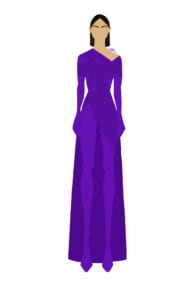Fashion creates a medium to express oneself in a way that is not readily found in other art forms. Today, it is commonly used as a symbol to communicate beliefs, feelings, or stories without words. Specifically, the color palette, texture, type of fabric, and adornments, as well as the design of the garment, can be used to convey a deeper meaning. With the loss of my father to Amyotrophic lateral sclerosis (ALS) at an early age and a close friend two years ago in a tragic boating accident, I began to experience grief. Such losses and feelings have empowered me to use my stories to support others suffering from mental health issues and inspired me to design a garment that captures the experience of mental health disorders.

Suffering from psychological disorders such as depression, bipolar disorder, and anxiety, people can feel trapped in their bodies and feel unable to escape. This feeling of entrapment is symbolized by the draping design of this garment’s inner bodysuit and mid-layer bodice, as the fabric drapes tightly around the top, arms, and waist. The design is subtle, almost understated, on a loosely cascading satin-silk fabric floor-length skirt, symbolizing that from the outside, others may not be able to realize how deep one’s pain is.
In addition, oftentimes those with mental health disorders may feel embarrassed and reluctant to seek help (Rüsch et al., 2013). They may attempt to ignore their symptoms or believe that they are hopeless and will never feel “normal” again (Rickwood, 2005; Rüsch et al., 2013). Therefore, to express a sense of empowerment and hope through this dress, a purple palette was chosen. Widely used as a symbol of power, purple in this garment represents the power one owns and acquires through seeking necessary support, which enables the individual to overcome mental health obstacles and ultimately reach inner peace. It also signifies the hope of healing from mental health disorders and achieving better psychological well-being. Overall, the resulting aesthetic of this garment visualizes the feelings of people with mental health difficulties and conveys to them hope and confidence that there will be better days ahead.
References
Rickwood, D., Deane, F. P., Wilson, C. J., & Ciarrochi, J. (2005). Young people’s help-seeking for mental health problems. Australian e-Journal for the Advancement of Mental Health, 4(3), 218-251. https://doi.org/10.5172/jamh.4.3.218
Rüsch, N., Müller, M., Ajdacic-Gross, V., Rodgers, S., Corrigan, P. W., & Rössler, W. (2014). Shame, perceived knowledge and satisfaction associated with mental health as predictors of attitude patterns towards help-seeking. Epidemiology and Psychiatric Sciences, 23(2), 177-187. https://doi.org/10.1017/S204579601300036X
